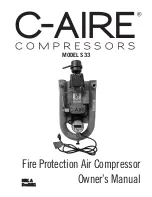
5
ENGLISH
• Do not aim the nozzles, sprinklers or the
air jet towards people or animals.
• Never inhale the compressed air
directly from the air compressor. It is not adequate as
breathing air.
• Do not adjust the regulator above the
maximum pressure marked in the accessory. Otherwise,
the compressor may burst.
• Operate the compressor on a perfectly level surface.
• Keep the compressor well ventilated. Do not cover it
while its running.
• The compressor gets hot while running.
Do not touch it or allow children get close during or
immediately after using it. Do not user it without the motor
cover. Work away from flammable objects or liquids.
• The air hose components may get hot during use. Leave
them to cool down before disconnecting.
• Do not use the air hose to move the compressor.
• Do not leave the compressor connected to the power
supply if not taking care of it during long periods of time.
Disconnect the tool after working with it.
• Using accessories not recommended by
may result in personal injuries.
• Under the cover, high temperatures are produced, and
there are moving parts. To prevent burns or other type of
injuries, do not operate without having the cover in place.
Give the compressor cooling-down time before handling
or servicing.
• Do not release any of the connections when the tank is
under pressure.
• The equipment, when operated, may be
an ignition source. Keep the equipment away at least 18 ft
away from explosive vapors like gasoline or other solvents.
Always operate the equipment in a well-ventilated area. Do
not operate in enclosed areas. Do not smoke while
spraying. Do not spray in flammable environments.
Keep the compressor as far away as possible from the
spraying area.
• Solvents like trichloroethane and
methylene chloride may have a chemical reaction with the
aluminum used in the paint spraying guns, paint pumps,
etc., and may cause an explosion. If using those solvents,
use only stainless-steel spraying equipment. This will not
affect the air compressor but may affect the equipment
being used.
• For any reason, do not carry out
welding jobs in the compressor air tank because it creates
a very dangerous situation. If carrying out a welding job in
the tank, the Warranty is void.
• When raining or in wet surfaces, never
use the compressor outdoors. Danger of electric discharge.
• Check the maximum pressure specified
by the manufacturer for pneumatic tools and accessories.
The compressor outlet pressure shall be regulated so that
in never exceeds the maximum specified pressure.
• Keep in place the labels and nameplates. They have
important safety information. If the labels or nameplates
cannot be read or are missing, contact a
Authorized Service Center to get
spares.
• For any reason, do not modify the
compressor or the release valve. Doing it will make the
Warranty void. Those parts are factory adjusted for this
unit maximum pressure.
• Double check all the labels in the paint
or toxic materials you will spray. Follow the safety
instructions. Wear a breathing mask if there is a possibility
of inhaling the material sprayed. Read the breathing mask
instructions to make sure it delivers the adequate
protection.
• Always wear safety eyeglasses when
using an air compressor.
• To allow a better cooling ventilation, the compressor shall
be kept 12” minimum distance away from the closest wall
and in a well-ventilated area.
• The environment temperature recommended for the
compressor operation es from 32 °F to 95 °F
CAUTION
DANGER
DANGER
Before using the compressor
While operating the compressor
• Remember, the unit starts automatically. Always turn
OFF the compressor. Remove the plug from the power
supply. Purge and release all the pressure from the
system before servicing or when not in use.
• Periodically drain humidity from the tank. A clean and
dry tank will help with corrosion.
• Pull the pressure release valve ring daily to make sure it
works correctly and to remove from the valve any
obstruction.
• If transporting the compressor, fasten in adequately.
Release the tank pressure before transporting.
• Protect the air hose and electric cable to detect weak or
worn out points. Replace if necessary.
After using the compressor
CAUTION
CAUTION
CAUTION
CAUTION
CAUTION
CAUTION
CAUTION
WARNING
WARNING
Safety Warnings for Using
Air Compressors
Summary of Contents for COMP-12S
Page 10: ...10 Notas ESPA OL...
Page 22: ...10 Notes ENGLISH...








































